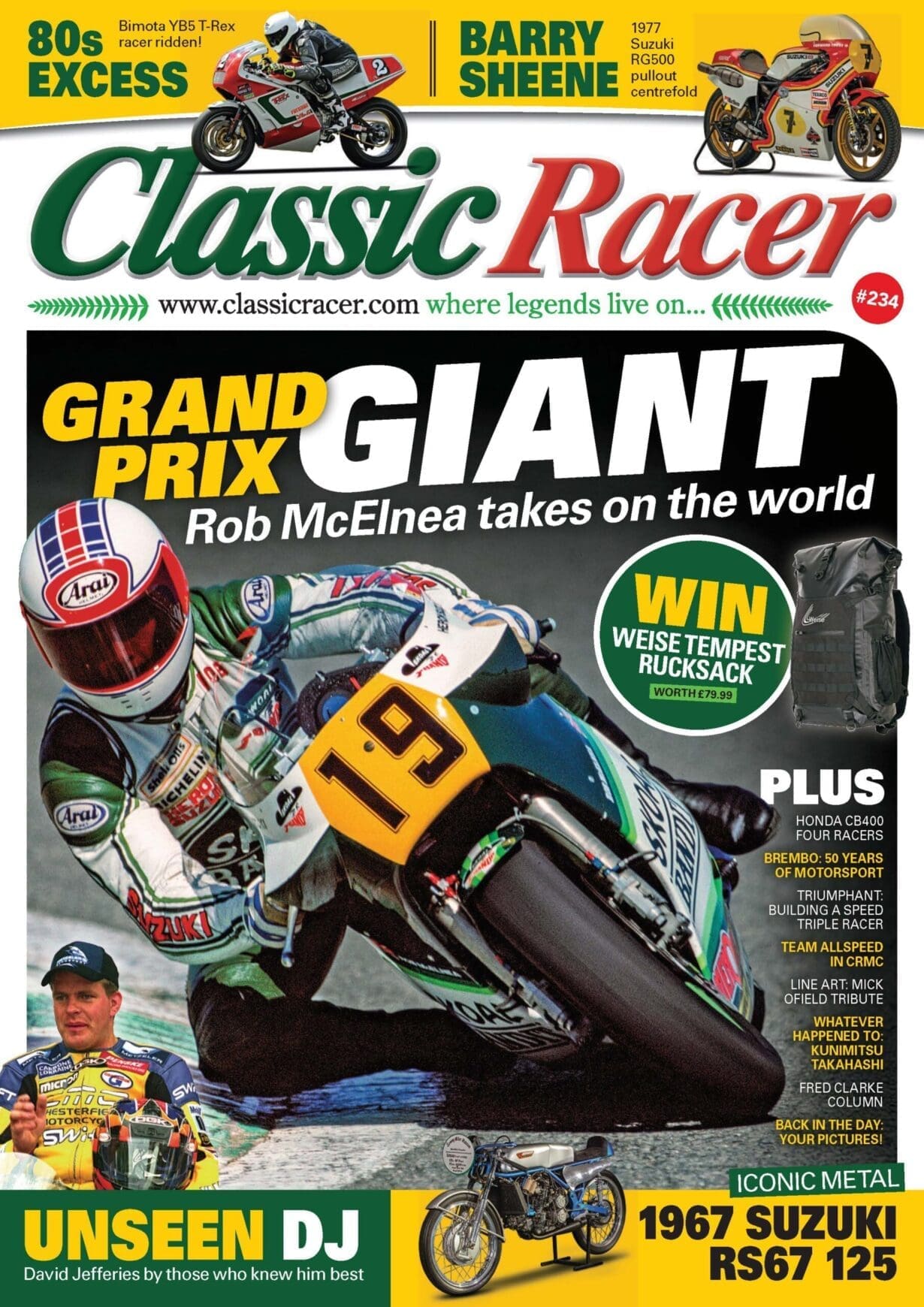Words: John Parnham Photographs: John Parnham Collection and Joe Dick – www.mortonsarchive.com
Every racing motorcycle has a story to tell, but a chance encounter with Carlos Lavado revealed that this TZ may have a more interesting history than most. At that moment we could not have guessed how interesting it was.
What had Carlos Lavado’s experienced eye recognised? He’d seen the brackets for the YPVS motor and the magnesium alloy, adjustable top yoke that were fitted to OW47s and were part of the factory kit supplied to chosen teams in 1983. While much of the factory kit was removed when the bike was converted to run with Hummel cylinders (something that every rider/team fitted if they could afford to do so), these tell-tale parts remain.
A factory bike?
With the belief that this was a factory bike, and with the support of Classic Racer magazine, we contacted Ferry Brouwer (an exceptional race engineer with the Yamaha Motor Company and a man with an encyclopaedic knowledge of Yamaha race machinery).
After studying photographs of the bike, Ferry was able to confirm that our TZ had indeed been factory kitted.
Armed with this confirmation, we started the long job of poring over photographs of the chosen Yamaha riders looking for any identifying features – not an easy job considering the pace of development throughout the year.

After a long search, this close scrutiny revealed that the Sonauto Gauloises team was unique in fitting bolts to the swinging arms of its Yamahas (presumably to fit a paddock stand). Inspection of our bike revealed metal putty in exactly the right place – we almost certainly had one of the Sonauto Gauloises Yamahas; but which one?
With this belief, we contacted Jacky Germain (an outstanding engineer and later team manager for the Sonauto Gauloises team). Jacky kindly confirmed for us that this TZ was indeed used by the Sonauto Gauloises team in 1983 – this was one of two bikes ridden in the 250cc GP series by Thierry Rapicault.
Grand Prix Life
Following the scrapping of the 350cc class at the end of the previous season, the 250cc class became even more competitive in 1983 as some riders and teams who had focused their efforts on the larger-capacity class chose to channel their efforts into the 250s.
With many equally matched machines, and a very strong field, 250cc GPs that year were frequently characterised by hard racing and multi-rider battles for every position.
Having won the Coupe Yamaha Gauloises the previous year, 1983 also marked Thierry Rapicault’s first year in the Grand Prix. Despite the ferocity of the competition he enjoyed a successful first season, finishing the year in 14th place in the 250cc Grand Prix standings.
He made his Grand Prix debut at the first South African Grand Prix at Kyalami – having qualified in fifth position, he battled with veteran 250cc riders Carlos Lavado (who would win the World Championship) and Martin Wimmer before finishing in ninth position.
Later in the year, he would be part of 10-rider battles for the victory in both the British GP (eventually finishing in eighth position, only 1.82 seconds behind the victorious Jacques Bolle) and the rain-interrupted Austrian GP (before being black flagged for overtaking under yellow flags).
However, the highlight of Rapicault’s first season had to be finishing on the podium, at his home race, in only his second Grand Prix.
Before the French Grand Prix, both the Sonauto Gauloises and Mitsui teams received Yamaha factory kits, for their production TZ250Ks; included in the kits were magnesium alloy top and bottom fork yokes, electronic power valves, new exhausts and re-jetted carburettors, all of which helped to narrow the performance gap to some of the other machines.

At the previous South African Grand Prix Alan Carter recalls that his Mitsui Yamaha was ‘Blown away by the straight line speed of Patrick Fernandez’s Hummel cylinder Yamaha’ and that he couldn’t slipstream the rapid Chevallier Yamahas of Baldé, de Radigues and Espié.
The weather for the French Grand Prix weekend was cold and wet; it even snowed on the morning. The cold temperatures, combined with Dunlop front slick tyres which were too hard for the conditions, led to a spate of crashes throughout the weekend and a somewhat topsy-turvy grid. However, the race started with all riders using slick tyres on a cold but predominantly dry track.
From his 14th place on the grid, Rapicault got a poor start but had so much more confidence that he was braking 20yds later than other riders into the Esses. He rapidly cut his way through the field, eventually overtaking Jacques Cornu and building a lead of several seconds.
Alan Carter was also cutting his way rapidly through the pack. He had started from 32nd place on the grid following mechanical problems caused by the new power-valve system during practice. However, he was alone in using a super-soft front slick from the previous year.
A few laps before the end of the race it started to spit with rain; Rapicault’s pace slowed and he was overtaken by Alan Carter at the end of the penultimate lap and then, on the last lap, re-passed by Jacques Cornu.
Some suggest that Rapicault’s inexperience led him to slow too much when it started to rain, others that he slowed with a flat battery – whatever the reason, it was a great result in only their second Grand Prix for both Thierry Rapicault and the victorious Alan Carter.
New Life in the UK
Both of Rapicault’s bikes came to the UK for the 1984 season. The bikes had been used hard during the previous year and had some of their more expensive parts, such as their Campagnolo wheels, removed but, much of the important factory kits remained.
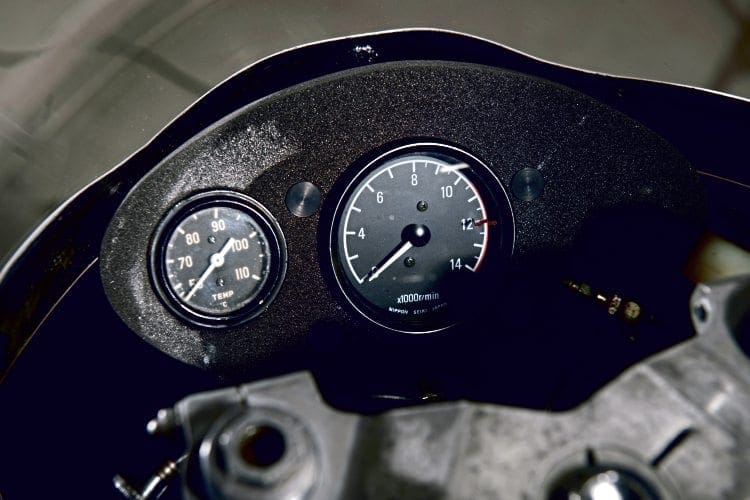
The first bike went to Andy Machin, an established star of the day and during 2015 a crew chief with the Core Motorsport Team in the World Supersport Championship seeing both Ratthapark Wilairot and PJ Jacobsen to victories.
Andy had ridden a standard TZ250K, with a mechanical power valve, a few times during the 1983 season. That bike had been really quick and he remembers his anticipation at getting what was essentially a year-old factory bike, with an electronic power valve, for the 1984 season.
Andy had first choice of the two bikes; as he recalls: “It was obvious that both bikes had done a lot of work and both had a lot of wear in the power valve mechanism.”
Apart from the electronic power valve and magnesium yokes, the rest of the bike was standard, including spoked wheels with the original Japanese Dunlop slicks.
He stripped both bikes of their cylinders to inspect the cylinders and cranks, choosing the bike with the least detonation damage to the cylinders and heads and in the best overall condition.
During his first few outings it became clear that the Grand Prix season had taken its toll on his bike – not only were some parts heavily worn but the bike was slow. It also had major handling problems; it didn’t steer well and it had a lot of chatter off-throttle.
A series of upgrades followed; the YPVS kit was removed and the cylinders replaced with Hummels, the Yamaha pipes were replaced with Exactwelds; Andy’s father Jack Machin refabricated these so that they matched the volumes of the Yamaha pipes to improve performance, an extra radiator was fitted, and they even fabricated an air box from the fibre sheeting used in model cars.
As Andy recalls, after all of this work, “It finally felt like a fast bike, and it was.” The handing problems remained though and had to be resolved.
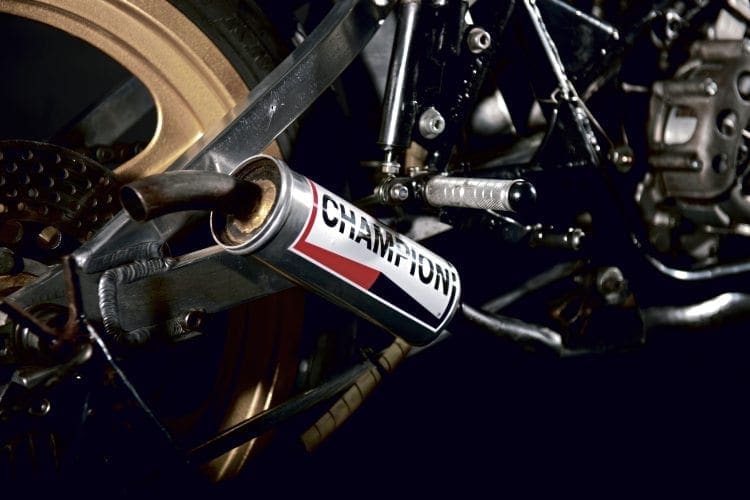
A trip to Spondon Engineering revealed the cause; the frame was bent. This was straightened in time for the September International meeting at Oliver’s Mount, Scarborough – on the weekend of Andy’s 19th birthday, with a bike that finally performed and handled properly, Andy finished third.
This was to be the turning point of the season and more success soon followed. At a meeting at Carnaby shortly afterwards, and with all of the top domestic 250 men present, he finished second to Donnie McLeod.
Andy used his bike for a couple of years before swapping to a Rotax in 1986. In 1987, he finished as runner-up in both the 250cc ACU Star British Championship and the 250cc Motoprix British Championship.
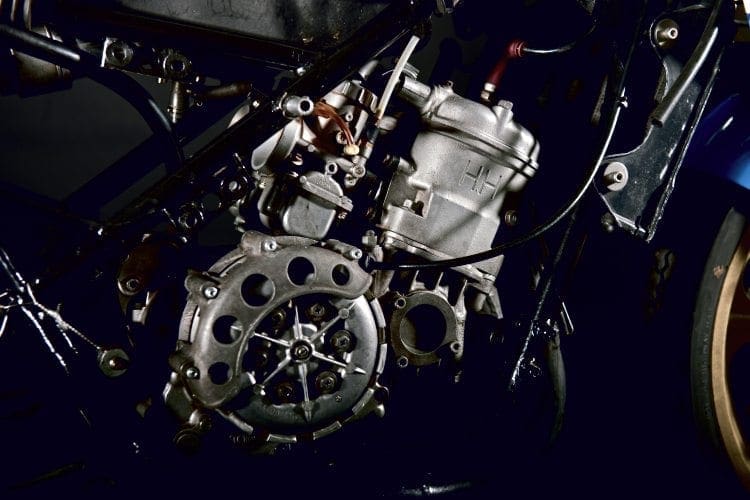
The second bike went to an up-and-coming rider by the name of Carl Fogarty. This was the bike on which Carl proved to himself that he could make it to the top – this in spite of crashing first time out at Snetterton when the throttle stuck wide open going into Riches on the third lap. Geoff Fowler remembers the bike well.
He visited the Fogartys when they first got the bike and helped George Fogarty to set up the suspension – he recalls that the bike was ‘in a bit of a state but was bl***y quick.’
Everyone remembers the speed of Carl’s bike; at one of Carl’s early outings on the bike at Oulton Park he finished second to Chris Martin on an RG500 Suzuki and in front of a TZ700 Yamaha. David Hopkinson (Chris Martin’s mechanic) remembers talking to the lad who finished third on the TZ700 who ‘couldn’t believe how fast Carl’s bike was.’
During the season, Carl was learning the style that was necessary to be fast in the 250cc class but they also developed the bike and by the end of the year Carl was winning regularly at different circuits, breaking club lap records and enjoying some success in the Marlboro ACU Clubmans Championship, including a fourth place at the final round at Silverstone. Carl sold his bike before the ’85 season.
Which bike?
As a testament to the tuners who have worked on this bike, it is still known to be a very fast TZ. The late Pete Hubbard won on it in the fore-runner to the ICGP Championship and, as Rob Maltby recalls, at a fast parade at Spa-Francorchamps the only 250s that were faster along the straight were ridden by Carlos Lavado and Freddie Spencer.

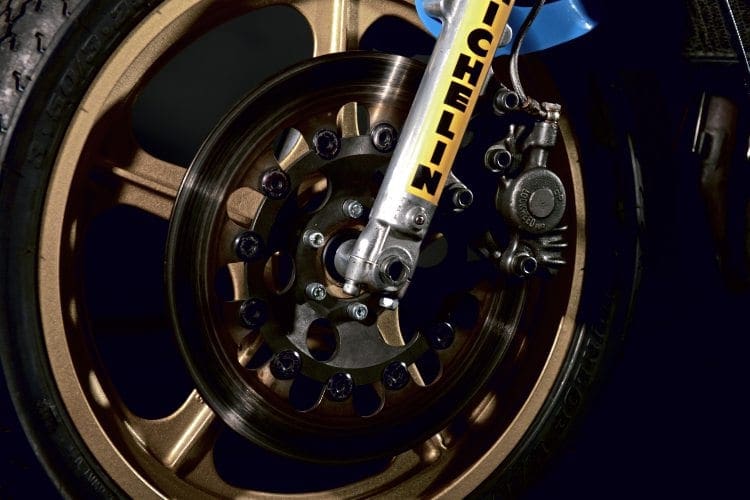
So, which of the two Rapicault TZs is this? Unfortunately, as there are gaps in the chain of ownership we may never know. The Rapicault TZs still linger in the memories of both the paddock and spectators alike. If anyone has any recollections about the ex-Rapicault bikes or can help to fill in the gaps in ownership, please let us know via Classic Racer.
Thanks
The motorcycle racing community, by its very nature, has always been closely knit. During this research people have been very generous with their time, recollections and expertise without which this story could not have been told and for which the author is very grateful.
The author also wishes to recognise the Motocourse history of the 1983 season, along with Alan Carter’s and Carl Fogarty’s autobiographies all of which contained much useful information that contributed to this article.

The restoration
The bike was in very good mechanical condition when we bought it; as such, the restoration was principally cosmetic.
The first job was to restore the bike to the appropriate Sonauto Gauloises colours (in the author’s opinion, one of the most attractive and effective colour schemes in GP history). Dream Machine was contacted and produced a finish that transformed the bike. At the same time, the metal putty was removed from the swinging arm and Allen bolts re-fitted.
Finally, period Campagnolo wheels were sourced to replace the Astralites which had been fitted – these would have to be crack-tested if the bike is ever to be ridden. Now to obtain the missing parts of the factory kit!
Read more News and Features online at www.classicracer.com and in the latest issue of Classic Racer – on sale now!


